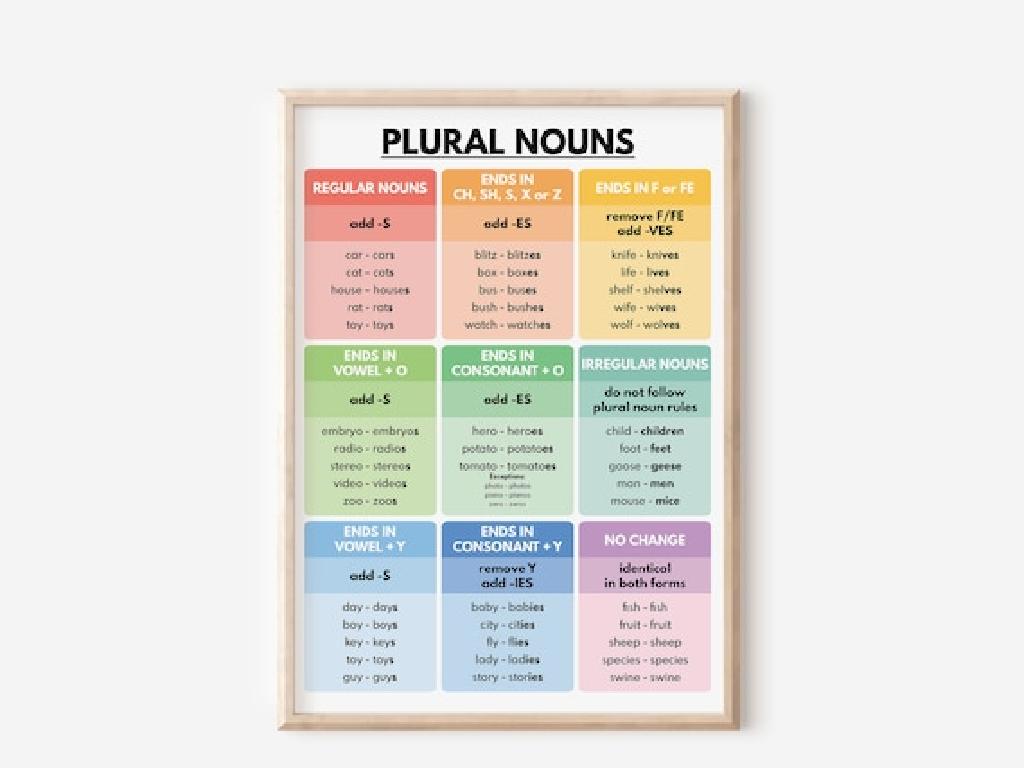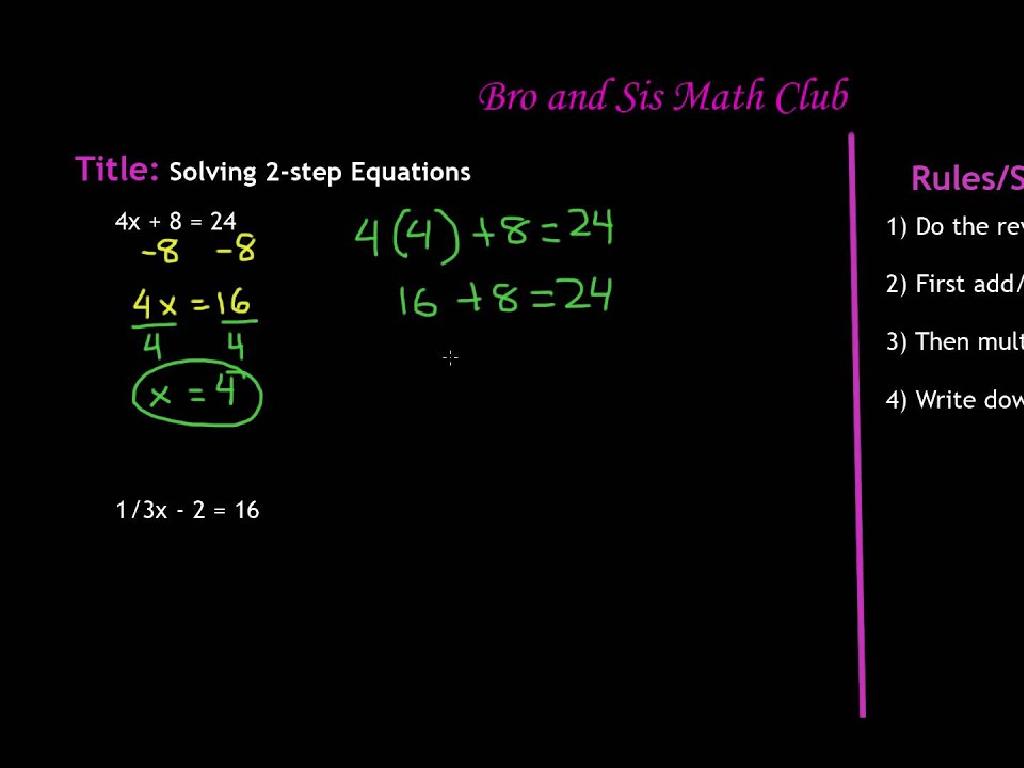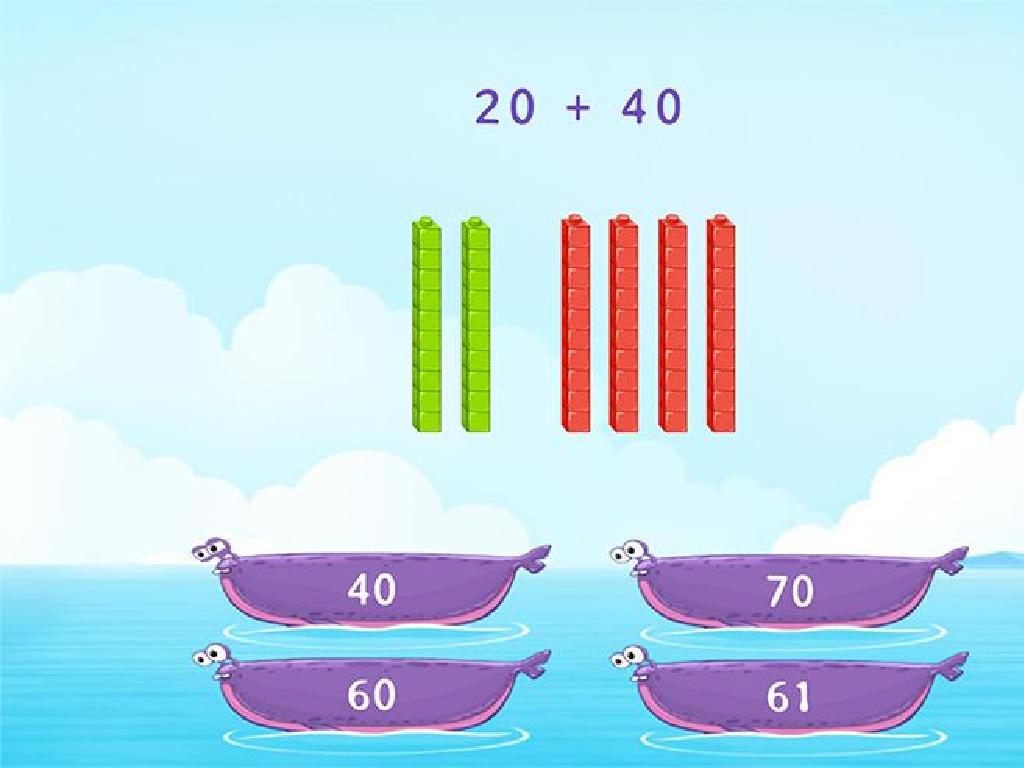Count Coins And Bills - Up To $5 Bill
Subject: Math
Grade: Third grade
Topic: Money
Please LOG IN to download the presentation. Access is available to registered users only.
View More Content
Welcome to Money Math!
– Understanding coins and bills
– Recognize pennies, nickels, dimes, quarters, and bills
– Importance of counting money
– Counting money helps with buying things and making change
– Today’s goal: Count up to $5
– Learn to add different values up to a $5 bill
– Practice with real examples
– Use examples like buying a toy or a snack
|
This slide introduces students to the concept of money, specifically focusing on coins and bills up to a $5 bill. Start by showing real or play coins and bills to help students recognize each type. Discuss the importance of counting money, such as when making purchases or giving change. Set the goal for the day to be able to count mixed coins and bills up to a $5 bill. Use relatable examples, such as buying a toy or a snack, to demonstrate how to count money in real-life scenarios. Encourage students to practice with various combinations of coins and bills to reach sums up to $5. This will prepare them for the activities ahead and help solidify their understanding of the value of different denominations.
Meet the Coins!
– Identify: Penny, Nickel, Dime, Quarter
– A penny is copper, nickel is larger and silver, dime is small and thin, quarter is biggest.
– Learn coin values
– Penny = 1 cent, Nickel = 5 cents, Dime = 10 cents, Quarter = 25 cents.
– Fun Fact about the penny
– A penny is worth 1 cent, the smallest value of U.S. money.
– Practice counting coins
|
This slide introduces students to the basic coins used in U.S. currency. Start by showing real coins or images of a penny, nickel, dime, and quarter. Help students identify each coin by its size, color, and any distinct markings. Discuss the value of each coin, reinforcing the concept that 100 cents equal one dollar. The fun fact about the penny can be a gateway to discuss why we use coins, their history, and their physical characteristics. Conclude with an activity where students practice counting coins, starting with pennies and working up to combinations of coins that add up to amounts less than a dollar.
Counting Coins: Mastering Money Math
– Learn to count coins effectively
– Add up coins of different values to find the total amount.
– Always start with the largest coin
– Begin with quarters, then dimes, nickels, and finally pennies.
– Practice with quarters and dimes
– Example: 2 quarters + 3 dimes = 50 cents + 30 cents = 80 cents.
– Understand value combinations
– Learn how different coins add up to the same value, like how 5 dimes equal 1 half-dollar.
|
This slide introduces students to the concept of counting coins, an essential skill for understanding money and making purchases. Emphasize starting with the largest value coin to make counting easier and more efficient. Use real coins or visual aids to demonstrate counting with quarters and dimes, and show how different combinations of coins can add up to the same value. For the class activity, provide various sets of coins and have students practice counting to reach a total amount. Encourage them to check their work by recounting and to explore different ways to reach the same total using various coins.
Meet the Bills!
– Recognize $1 and $5 bills
– Look at the pictures and numbers to tell them apart
– Understand bill values
– $1 is one dollar, $5 is five dollars
– Discuss purchases with $1 or $5
– Think of examples like a snack or a toy
– Smart spending tips
– How to make good choices with money
|
This slide introduces students to the $1 and $5 bills, which are fundamental components of understanding money. Start by showing the students real or play bills and pointing out the distinguishing features, such as the numbers and the pictures of the presidents. Explain that the value of the bill is not just a number but represents how much something is worth. Engage the class in a discussion about what items they could potentially buy with $1 or $5, which will help them relate the concept of money to their everyday lives. Finally, provide some basic tips on spending wisely, like comparing prices or thinking about needs versus wants. This will set the foundation for responsible financial habits.
Counting with Bills: Making $5
– Tips for counting bills efficiently
– Practice with $1 bills to reach $5
– Count five $1 bills to make a total of $5
– Explore ways to make $5
– Use $1 and $5 bills to find all combinations
– Understand the value of different bills
|
This slide is aimed at teaching students how to count money using bills, with a focus on understanding the value of $1 and $5 bills. Start by discussing strategies for counting bills efficiently, such as stacking them neatly or counting aloud. Then, engage the students in a hands-on practice activity where they count out $1 bills to make a total of $5. Challenge the students to think of different combinations of $1 and $5 bills that can add up to $5, reinforcing their understanding of addition and the concept of equivalent values. In the next class, students can share the different combinations they found and discuss the various methods they used to count. This activity not only teaches them about money but also enhances their problem-solving and arithmetic skills.
Combining Coins and Bills: Counting Money
– Count coins and bills step by step
– Start with the largest value, count bills first then coins
– Use tips for accurate counting
– Stack coins in groups, like 5s or 10s, to count easily
– Example with quarters, dimes, and pennies
– 2 quarters (50¢), 3 dimes (30¢), 4 pennies (4¢) makes 84¢
– Adding a $5 bill to your total
– Combine 84¢ with $5 bill for a total of $5.84
|
When teaching students to count a combination of coins and bills, start by explaining the value of each coin and bill. Demonstrate counting by starting with the largest denomination (the $5 bill) and working down to the smallest (pennies). Provide tips such as grouping coins to make counting easier and double-checking their count before adding it to the bill amount. Use the example provided to walk through the process step by step, showing how to add the value of coins (84¢) to the value of the bill ($5) to find the total amount ($5.84). Encourage students to practice with real or play money to build their confidence and accuracy in counting money.
Let’s Practice Counting Money!
– Engage in an interactive counting game
– Pair up and count various money combos
– Use real or play coins and bills up to $5
– Discuss your findings with a partner
– How much money did you both count?
– Share your results with the class
|
This slide introduces an interactive class activity focused on counting money. Students will be paired up to reinforce teamwork and peer learning. Provide them with a mix of coins and bills up to a $5 bill and ask them to count the total value. They should discuss their strategies and findings with their partner to ensure they agree on the total amount. Afterward, each pair will share their results with the class, fostering a collaborative learning environment. As a teacher, prepare different sets of money combinations for each pair, ensure all students are engaged, and offer guidance as needed. Possible activities include: counting by ones using bills, grouping coins to make a dollar, and mixing coins and bills to reach a total of $5.
Using Money in Real Life: Buying a Toy
– Understanding money through play
– Scenario: Purchasing a toy
– Imagine you’re buying a toy with your own money
– Activity: Calculating change
– If a toy costs $3 and you pay with a $5 bill, how much change do you get?
– Math skills in daily life
|
This slide introduces students to the practical use of money through an engaging scenario where they imagine buying a toy. The activity is designed to help students apply their knowledge of counting coins and bills to determine the correct amount of change they should receive after a purchase. Teachers should prepare a few examples with different amounts and encourage students to use subtraction to find the answer. For instance, if a toy costs $2.75 and the student pays with a $5 bill, they should calculate $5.00 – $2.75 to find the change. This exercise will reinforce their subtraction skills and understanding of money. Provide real coins and bills for practice if possible, and consider role-playing as a cashier to make the activity more interactive.
Class Activity: Money Math Store
– Set up a classroom store
– Use play money for transactions
– Count out the correct amount
– Practice with coins and bills up to $5
– Calculate change after purchase
– If an item costs $3 and you pay with a $5 bill, how much change do you get?
|
This activity is designed to give students practical experience with counting money and understanding transactions. Set up a small store in the classroom with various items and price tags. Provide students with play money in denominations up to $5. Students will choose items to ‘purchase’ and then count out the correct amount of money to ‘pay’ for the items. Afterward, they will calculate the change they should receive back. This hands-on activity helps reinforce their understanding of the value of coins and bills, addition and subtraction skills, and the concept of making purchases. Possible variations of the activity could include having students take turns being the cashier, offering discounts for certain items, or setting a budget limit for each student to manage.
Conclusion: The Value of Money
– Recap: Counting coins and bills
– Importance of accurate money counting
Helps with making correct payments and receiving the right change.
– Homework: Track your spending
Record all money spent for a week in a diary.
– Why keep a money diary?
It teaches budgeting and awareness of spending habits.
|
As we wrap up today’s lesson on counting coins and bills, it’s crucial to emphasize to students the real-world application of what they’ve learned. Accurate counting ensures correct transactions in everyday purchases. For homework, students will maintain a money diary, which will help them understand their spending patterns and the importance of budgeting. This activity will also reinforce their counting skills as they track their expenses. In the next class, we can discuss their observations and insights from this exercise, fostering a practical understanding of money management.






